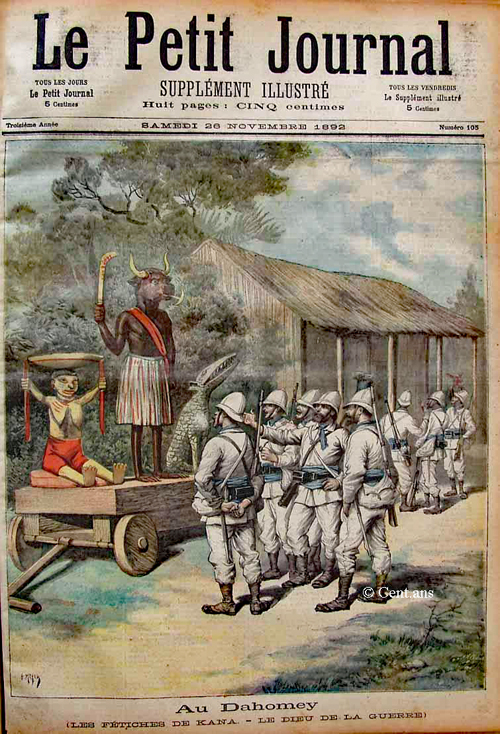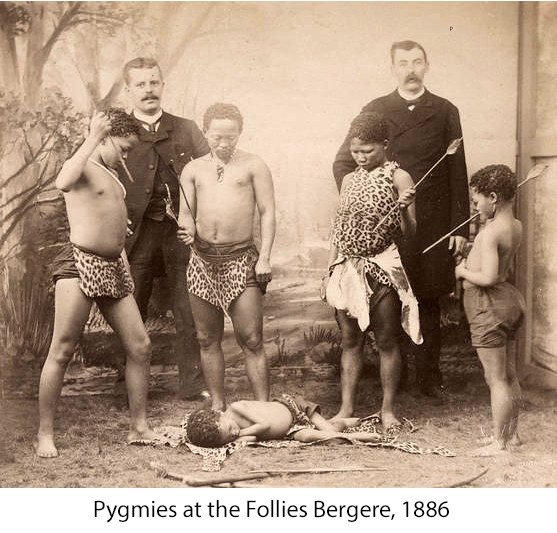Day 14 -- Race and Visions of Africa
Emmanuelle Sibeud, “’Negrophilia,’
‘Negrology’ or ‘Africanism’? Colonial Ethnography and Racism in France
around 1900” in Tony Chafer and Amanda Sackur,
Promoting the Colonial Idea: Propaganda and Visions of Empire in France
(Chppenham, Wiltshire: Palgrave, 2002), pp.156, 158-161
The 1900 Universal Exhibition can be
considered, in view of the space allotted to the colonial pavilions, to be
the first French colonial exhibition. The colonial section comprised
numerous didactic items, with exhibits and erudite comments on people living
under colonial domination, the burden of which was that the period of
conquest was over and the time had come to move on to rational exploitation
based on methodical inventory. Here we propose to look behind the scenes of
this triumphant production, focusing on the particular case of Africa and
Africans. The Universal Exhibition did not offer a comprehensive view but
rather took a position firmly in the context of French metropolitan
controversies and crystallised latent contradictions at the junction of the
nineteenth and twentieth centuries. The fact is that colonial figures --
administrators, officers and missionaries -- had been drawing more and more
precise pictures which differed greatly from the very general perspectives
contributed by earlier explorers, and the period lends itself particularly
well to examination of the changes in representations of Africa brought
about by the colonial experience. . . .
exhibition. The colonial section comprised
numerous didactic items, with exhibits and erudite comments on people living
under colonial domination, the burden of which was that the period of
conquest was over and the time had come to move on to rational exploitation
based on methodical inventory. Here we propose to look behind the scenes of
this triumphant production, focusing on the particular case of Africa and
Africans. The Universal Exhibition did not offer a comprehensive view but
rather took a position firmly in the context of French metropolitan
controversies and crystallised latent contradictions at the junction of the
nineteenth and twentieth centuries. The fact is that colonial figures --
administrators, officers and missionaries -- had been drawing more and more
precise pictures which differed greatly from the very general perspectives
contributed by earlier explorers, and the period lends itself particularly
well to examination of the changes in representations of Africa brought
about by the colonial experience. . . .
in less than an hour we were made to believe we were ourselves explorers in Central Africa. We could see the villages in the bush poorly protected by wooden palisades against raids and fire, the fierce countenances of man-hunters, negroes dragged in chains far from their birthplace in long processions to the slave markets. We would see the unhappy mothers when the slave trader tore the baby from their breast to dash its head against a wayside stone so as to get rid of a useless load and not hamper the march of the captives . . .
Even from an anatomical point of view, the negro race
is visibly at a much lower level of development. Negro brains are more grey
in colour than those of other races. The virtually simian prognathism [the
relationship of the jaw to the face], the angle of the face, the section
of the hair dearly differentiate it from the rest of humanity . . . in its
own interest it is absurd to impose on it a civilisation it cannot
assimilate and which is fatal for it . . . African blacks feel this and, at
the approach of the white man, they resort to Mahometanism.
 This way of confusing 'negro race' and
'African blacks' shows how little the stereotypes prevalent in 1900 had to
do with the more differentiated descriptions by explorers and even less with
the body of knowledge amassed by colonial savants. As the rift widened, the
old opposition between negrophiles and negrophobes once more reared its
head. Some philanthropists and the new specialists on Africa took up the
negrophile line to combat the caricatures bandied about by colonial
sociology . . .
This way of confusing 'negro race' and
'African blacks' shows how little the stereotypes prevalent in 1900 had to
do with the more differentiated descriptions by explorers and even less with
the body of knowledge amassed by colonial savants. As the rift widened, the
old opposition between negrophiles and negrophobes once more reared its
head. Some philanthropists and the new specialists on Africa took up the
negrophile line to combat the caricatures bandied about by colonial
sociology . . .
The totally negative view of the negrophobes
was part of a process of denial which appears clearly when the article
'Africa' in the first edition of the Larousse Dictionary (published between
1864 and 1876) is compared with that in the second (1896-1906). By 1900,
Africa, conquered and dismembered, had become an object of contempt, even
down to the very shape of the continent which inspired a value judgement
other continents were spared:
There is no comparison that can help us to
describe the outline of Africa ...What is to be noted above all is the thick
massive nature of its shape, which contrasts strikingly with the slender
elegance of the shape of Europe, the most indented of all continents.
Furthermore, the lively discussion on
fetishism between an anonymous English traveler and Comoro, 'chief of a
negro tribe of the White Nile', in the first edition had been replaced in
the turn of the century edition by a horrifying enumeration of negative
characters of the negro race borrowed from anthropology and ethnography.